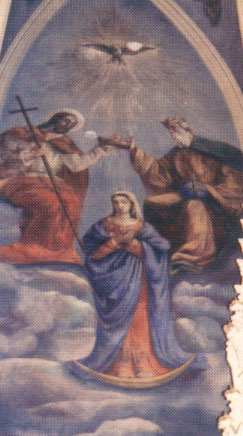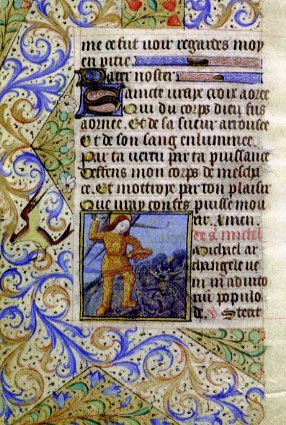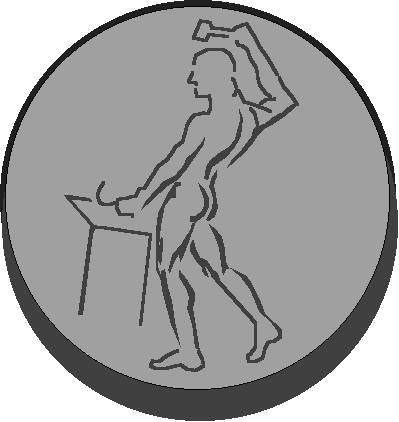|
Schema of the Time After Pentecost
X |
|
The progression of the Time After Pentecost, together with a select number of
saints' days, can be summarized as follows:
The Octave of Pentecost
(Note: technically this is not a part of the Time After Pentecost, but
its point of departure)
- Pentecost (Whitsunday).
Fifty days after Easter, the descent of the Holy Spirit on
the Apostles. One of the three greatest feasts of the liturgical year.
- Ember Wednesday within the Octave of Pentecost.
See Ember
Days, etc.
- Ember Friday within the Octave of Pentecost
- Ember Saturday within the Octave of Pentecost
- The end of Paschaltide (after the office of None on Saturday afternoon).
|
| The Time After
Pentecost
(Note: The following division into two parts is ours,
not the calendar's)
Part 1: Redeeming the times... |
- Trinity Sunday.
After the Son revealed His relation to the Father through Good
Friday and Easter, and the Spirit revealed Himself at Pentecost, the most Holy Trinity can
now be fully worshipped (see Customs
page).
- Feast of St. John the Baptist (June 24).
The greatest of the prophets and arguably
the least confused and wisest of Christ's disciples, John has the distinction of being the
only other person besides the Blessed Virgin and our Lord whose birthday is celebrated by
the Church (see Customs
page).
|

Birth of St.
John the Baptist |
- Feast of Corpus Christi.
In the U.S., said on the Sunday rather than the Thursday
after the Feast of the Holy Trinity. An adoration of the Food that sustains us on our
post-Pentecostal pilgrimage and "the pledge of our future glory" (Vespers)
(see Customs page).
- Feast of the Holy Apostles Peter and Paul (June 29)
. The grand rejoicing in the two
Princes of the Apostles and founders of the Church in Rome.
- Sacred Heart of Jesus.
(The Friday after the Octave of Corpus Christi.) A
celebration of God's love for all men, made manifest from Advent to Corpus Christi, and a
thanksgiving for all the divine favors we have received.
|

Primacy of
St. Peter |
- Third Sunday after Pentecost.
Because of God's mercy, the Holy Spirit works to build
the kingdom of God even in sinful souls.
- Fourth Sunday after Pentecost.
Trusting in God in the midst of troubles. The example
of St. Peter is given because of this Sunday's usual proximity to the Feast of Sts. Peter
and Paul.
- Fifth Sunday after Pentecost.
The importance of forgiving injuries. Again there is a
Petrine motif because of the proximity to the feast. (This Sunday was originally known as
the "First Sunday after the Feast of the Apostles.")
- Sixth Sunday after Pentecost.
The need for constant repentance and fidelity to our
baptismal vows.
- Seventh Sunday after Pentecost.
"Faith cannot save without virtue" (St.
John Chrysostom).
|
- Eighth Sunday after Pentecost.
The importance of intelligent foresight and the
fascinating passage on "the mammon of iniquity" (Lk. 16.9).
- Transfiguration of our Lord (Aug. 6).
The second commemoration during the liturgical
year of the miracle of the Transfiguration. (The first, on the second Sunday in Lent,
recalls Christ's divinity, while today emphasizes His triumph and glory.) Falling on a
Sunday this year, it replaces the Eighth Sunday after Pentecost.
- Ninth Sunday after Pentecost.
The necessity of being faithful to the end.
|

Transfiguration |
- The Feast of the Assumption of the Blessed Virgin Mary (August 15)
. The day that the
Mother of God was assumed body and soul into heaven and crowned Queen (see Customs page).
- Tenth Sunday after Pentecost.
Humility and its source in knowing that all goodness
comes from the Spirit.
- Eleventh Sunday after Pentecost.
Daily dying to our sins and rising to new life in
Christ.
- Twelfth Sunday after Pentecost.
True and laudable service as we run to attain the
eternal promises.
|

The coronation of the BVM, Holy
Trinity Church Sanctuary |
- Thirteenth Sunday after Pentecost.
An increase in faith, hope, and love.
- Fourteenth Sunday after Pentecost.
Seeking the kingdom of God and its justice.
- Ember Wednesday of September.
(Also called the Michaelmas Embertide because of its
proximity to St. Michael's Day. See Ember Days.)
Commemoration of the restoration of Jerusalem after the Babylonian exile.
- Ember Friday of September.
The profound importance of total conversion.
- Ember Saturday of September.
Commemoration of Yom Kippur and the
Feast of Tabernacles (both of which occur in the Jewish calendar around this
time), two important foreshadowings of the Christ event.
|
- Fifteenth Sunday after Pentecost.
Weeping over lost souls and rejoicing over
converted ones.
- Michaelmas (September 29).
The feast of the dedication of the church of St.
Michael the Archangel, which focuses more on the princely archangel himself (see Customs page).
- Sixteenth Sunday after Pentecost.
Good works and humility.
- Seventeenth Sunday after Pentecost.
The double love of God and neighbor.
|

St. Michael expelling the demons |
|
Part II: The final manifestation of Christ...
- Eighteenth Sunday after Pentecost. Sacrifice, forgiveness, and "confirmation in
the end without crime" (1 Cor. 4.8).
- Nineteenth Sunday after Pentecost.
The necessity of charity (caritas) for the
eternal wedding feast.
- Twentieth Sunday after Pentecost.
Making our hearts ready through faith as we
"redeem the times" (Eph. 5.15).
- Feast of Christ the King (last Sunday of October).
A celebration of Christ's rule
over His Church and an anticipation of His eternal reign over the new heaven and earth.
This year it replaces the Twentieth Sunday after Pentecost (see Customs page).
- All Saints' Day (November 1).
A glorious celebration of the entire communion of
saints (see Customs
page).
- All Souls' Day (November 2).
A mournful prayer for the souls in purgatory (see Customs page).
- Twenty First Sunday after Pentecost.
Spiritually arming oneself (for both now and
Armageddon) and forgiving each other so that we may be forgiven on Judgment Day.
- Twenty Second Sunday after Pentecost.
Rendering to God what is God's means that we
must give ourselves up entirely to Him so that He will recognize us on the Last Day.

- Twenty Third Sunday after Pentecost.
A reminder of the Book of Life and the
resurrection of the body.
- (Twenty Fourth to Twenty Seventh Sunday after Pentecost.)
These are "movable"
Sundays, parts of which are taken from the weeks after Epiphany. This year, however,
because of the date of Easter, all twenty seven of them will occur.
- Last Sunday after Pentecost.
The Last Judgment.
|




